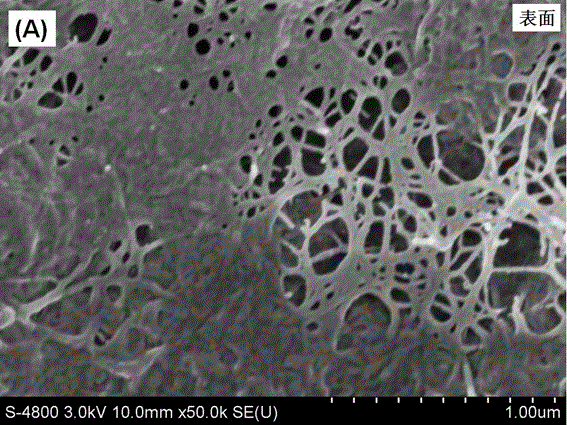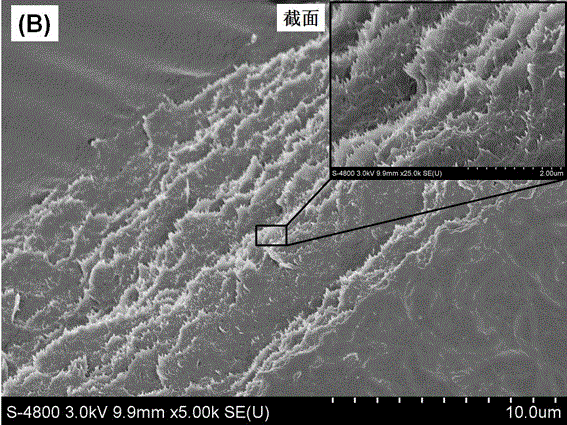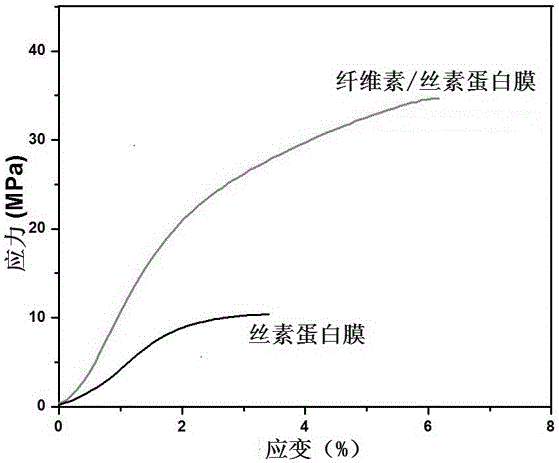Nano-cellulose reinforced silk fibroin composite material and preparation method thereof
A technology of nano-cellulose and composite materials, applied in the field of nano-cellulose-reinforced silk fibroin composite materials and its preparation, which can solve the problems of complex process, easy aggregation of cellulose nano-whiskers, and difficulty in dispersing fibers, etc. simple effect
- Summary
- Abstract
- Description
- Claims
- Application Information
AI Technical Summary
Problems solved by technology
Method used
Image
Examples
Embodiment 1
[0034] Immerse 100 g silkworm silk in 5 L of 0.05% NaCO 3 solution, boiled at 98-100°C for 30 min, and repeated three times to degumming the silk, fully washed and dried to obtain pure silk fibroin fibers; solution, stirring and dissolving at 60°C for 55 min to obtain a silk fibroin mixed solution;
[0035] Add 1 g of microcrystalline cellulose powder into 80 mL of 9.3 mol / L LiBr solution, stir and dissolve at 110°C for 55 min to obtain a cellulose solution;
[0036] Mix the silk fibroin solution and cellulose solution according to the mass ratio of silk fibroin and fiber 50:50, stir at 110°C for 5 minutes and mix evenly to obtain a silk fibroin / cellulose mixed solution, cool at room temperature to form a blended gel glue;
[0037] The above gel was soaked in 75% ethanol for 2 h, and then soaked in flowing deionized water for 48 h to remove LiBr;
[0038] The purified silk fibroin / cellulose gel was dried in a vacuum oven at 37 °C for 48 h to obtain a nanocellulose-reinforce...
Embodiment 2
[0041] Add 20 g of degummed silk fibroin fibers to 100 mL of 10 mol / L LiBr solution, stir and dissolve at 60°C for 58 min to obtain a silk fibroin mixed solution;
[0042] Add 2 g of microcrystalline cellulose powder into 160 mL of 10 mol / L LiBr solution, stir and dissolve at 110°C for 58 min to obtain a cellulose solution;
[0043] Mix the silk fibroin solution and the cellulose solution according to the mass ratio of silk fibroin and fiber 20:80, stir at 110° C. for 3 minutes and mix evenly to obtain a silk fibroin / cellulose mixed solution. Cooling at room temperature to form a blended gel;
[0044] The above gel was soaked in 50% ethanol for 2 h, and then soaked in running water for 48 h to remove LiBr;
[0045] The purified silk fibroin / cellulose gel was dehydrated successively with 50%, 75% tert-butanol and anhydrous tert-butanol for 30 min, and then frozen at -20°C for 24 h to obtain frozen solids.
[0046] The above-mentioned frozen solid was freeze-dried for 48 h accor...
Embodiment 3
[0049] Add 10 g of degummed silk fibroin fibers to 40 mL of 8 mol / L LiBr solution, stir and dissolve at 60°C for 120 min to obtain a silk fibroin mixed solution;
[0050] Add 1 g of cellulose filter paper into 100 mL of 8 mol / L LiBr solution, stir and dissolve at 90 °C for 4 h to obtain a cellulose solution;
[0051] Mix the silk fibroin solution and cellulose solution according to the mass ratio of silk fibroin and fiber 80:20, stir at 90°C for 5 min and mix well to obtain a silk fibroin / cellulose mixed solution; cool at room temperature to form a blended gel;
[0052] Soak the above gel in 90% methanol for 1 h, then soak in running water for 72 h to remove LiBr;
[0053] The purified silk fibroin / cellulose gel was dried in a vacuum oven at 37 °C for 48 h to obtain a nanocellulose-reinforced silk film.
PUM
| Property | Measurement | Unit |
|---|---|---|
| diameter | aaaaa | aaaaa |
| degree of polymerization | aaaaa | aaaaa |
Abstract
Description
Claims
Application Information
 Login to View More
Login to View More - R&D
- Intellectual Property
- Life Sciences
- Materials
- Tech Scout
- Unparalleled Data Quality
- Higher Quality Content
- 60% Fewer Hallucinations
Browse by: Latest US Patents, China's latest patents, Technical Efficacy Thesaurus, Application Domain, Technology Topic, Popular Technical Reports.
© 2025 PatSnap. All rights reserved.Legal|Privacy policy|Modern Slavery Act Transparency Statement|Sitemap|About US| Contact US: help@patsnap.com



